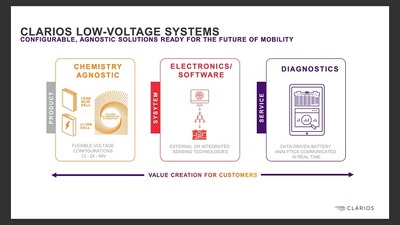Clarios’ view on the 12 Volt battery
You’ll always have power
What do a Bentley Bentayga or Continental GT, Ford F-150, Ferrari Purosangue and a Tesla Model Y have in common? It’s their 12 Volt battery. Since the 1920s when those simpler vehicles abandoned hand cranks in favor of an electric starter, the humble lead-acid battery has started our cars and kept the radio playing long into the night. Today, regardless internal combustion-powered, or across the wide variety of electrical architectures from multi-kilowatt battery to those using fuel cells to provide electric energy, all platforms continue to use some form of small energy storage device and will have a similar low-voltage power network for the foreseeable future.
In Munich, Germany, The Auto Channel attended a presentation by international battery powerhouse Clarios on the future of such low voltage networks and why they are critical. CEO Mark Wallace explained how batteries not only start a majority of today’s vehicles, but provide functional safety far beyond memorizing your favorite radio stations. That battery, whether a typical flooded battery, absorbent glass mat (AGM) or other advanced chemistry maintains vehicle diagnostics and analytics, performs over-the-air vehicle updates while you sleep, powers anti-theft systems and unlocks doors automatically.
Federico Morales Zimmermann, Vice President and General Manager, Global OEM Customers, Products and Engineering imparted the true significance of low-voltage networks. “We view digitalization, the external and internal sensors, safety-centric cameras, external information flows and then the functional safety requirements of future autonomous vehicles as impacting the electrical architecture of every vehicle.”
Federico explained how today’s Zone Architecture affects vehicle engineering. “As vehicles become more connected (think beyond current Apple CarPlay, SiriusXM weather and audio, or GPS and radar-based cruise control,) the amount of data that is shared within and beyond the vehicle is exploding. User experiences, like large and multiple screens, more and better safety systems, they all require us to collaborate with our OEM partners on system architectures.”
Beyond saved seat-and-mirror positions that adjust to each driver via their key fob or mobile phone, think about the promise of “shared mobility” and how vehicles can warn each other of nearby ice, wandering pedestrians, their current position and speed on the road and even pre-adjust to impending hills or tight curves. This requires and generates data, which demands keep-live power. Mobility as a Service robotaxis from Cruise, Waymo, or Didi require power when parked for a multitude of systems. And, every BEV or battery-electric vehicle must, in any serious accident, disconnect its massive battery in milliseconds, then depending on the low-voltage network to provide steering and brakes, open doors for passenger exit, notify safety services and save any relevant data.
As manufacturers “drag more hardware into vehicles, Zone Architecture becomes more important,” Federico continued. So, understanding functional Zones, like safety, comfort, entertainment and data, is core its competency, Clarios says. “A systems level approach that is agnostic to individual battery chemistry,” according to Zimmermann.
Familiar lead-acid, even lithium-ion battery chemistries aren’t the end game. Lithium-iron phosphate, sodium-ion and lithium-titanium -oxide chemistries are all under investigation or being supplied to Clarios’ customers. With iron and sodium being far more economical, interest is high. And 12 Volt batteries are being supplanted by 24-volt and 48-volt batteries, as higher voltage permits smaller, lighter wiring (and why you see EVs bragging about 800-900 Volt architectures).
Smart AGM systems for fleets, particularly Class 8 trucks, are on the horizon. These inter-communicating batteries provide diagnostic capabilities that result in greater and longer run times. Built-in data analytics can help diagnose vehicle woes by incorporating Artificial Intelligence algorithms with machine learning. For instance, monitoring engine cranking speed indicates engine health. Anything that keeps trucks running is hugely important to fleet owners.
According to Clarios, circularity or sustainability is a team sport and the company is the 2023 winner of the World Sustainability Awards’ “Circular Economy Award.” Already, the automotive battery is the most recycled part of a vehicle, over 99% in North America. As sustainability gains momentum, Clarios is adding capability to recycle lithium-ion batteries into what industry calls “black mass”. This scrap is up-cycled into new lithium-ion batteries, relieving stress on mining, refining and smelting, literally every aspect of battery production including the aluminum casing. Thus, reduced environmental carbon production.
Though you may not have heard of Clarios, it’s been in business for over 100 years and you know its OPTIMA, Delkor (Korea), Varta (Germany), Die Hard (USA), LTH and MAC (Mexico, SA and Caribbean), and private brands from Wal-Mart, BMW, Toyota and others.
Over the past two decades it had become fashionable to lambast American hegemony, to speak derisively of “American exceptionalism,” to ridicule America’s self-arrogated function of “world police” and to yearn for a multipolar world. Well, congratulations, now we have that world. See if you like it better.





